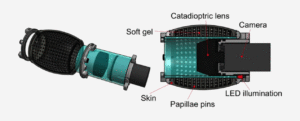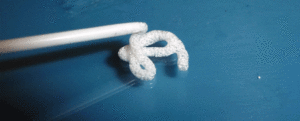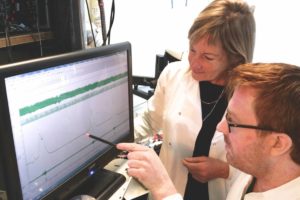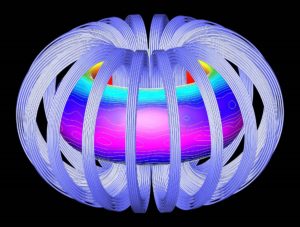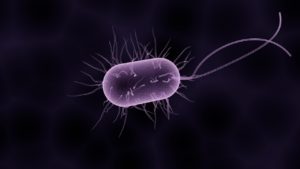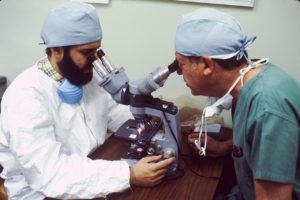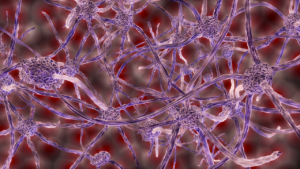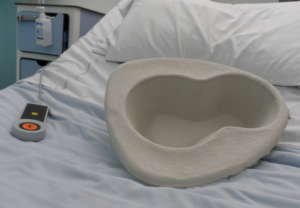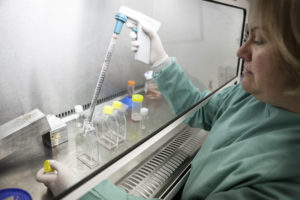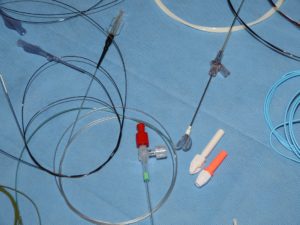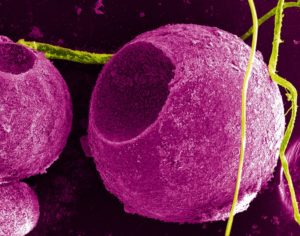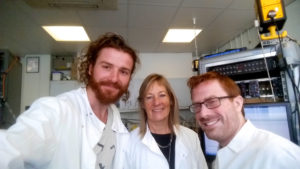Proof of concept projects
Modelling the Physiology of Faecal Incontinence Summary: Modelling the Physiology of Faecal Incontinence is a project which runs in parallel with another IMPRESS pilot scheme, the Tactile Sensing Caspule project at Bristol Robotics Lab. Together these projects work towards developing a smart anal plug device for combatting faecal incontinence. This particular project at Imperial College London focussed on understanding the physiological causes of faecal incontinence and aimed to tie them to the design of a device that is able to prevent the symptoms and also offer diagnostic capabilities. Background: The background for this project is the design of a smart device for fighting faecal incontinence. In two parallel projects, a sensing modality using TACTIP technology was contributed by the Bristol Robotics Laboratory, an anatomical test rig and material testing was contributed by the University of Leeds, and computational modelling was contributed by Imperial College London – with the latter providing the focus of this report. It is the on-going ambition of this work to understand the physiological causes of faecal incontinence and tie them to the design of a device that is able to prevent the symptoms and also offer diagnostic capabilities. An anal plug is one method for alleviating the symptoms of faecal incontinence and it was anticipated that a device of this type, with high resolution pressure sensing, would be able to indicate where physiological damage or weakness was contributing to the condition. At the University of Leeds, three critical components in the problem of faecal incontinence have been identified, among others, for further study. These are the anorectal angle and the performance of the internal and external anal sphincters. A phantom consisting of a rectum, anal canal (with sphincters) and puborectalis muscle were used as a basis for their investigation. Project Aim: The principal aim of the work presented here is to develop a numerical platform that captures the anatomical features of the test rig, enables investigation of physiological behaviour and can contribute to the most effective design of a smart device addressing faecal incontinence. A secondary aim is to provide a modelling environment that can be used for future analysis, including development to include the flow of faecal matter. Read full report here: Modelling-the-Physiology-of-faecal-incontinence Tactile Sensing Capsule for treating Faecal Incontinence Summary: Tactile Sensing Capsule complements the Imperial College London’s work on modelling the physiology of faecal incontinence by investigating the use of a sensing capsule developed by Bristol Robotics Lab in 2012. The Lab will explore whether this device, which has a 360 degree sensing capacity, could be used in the treatment of faecal incontinence to provide a more comprehensive set of recordings of muscular contractions in the rectum compared to current methods. The work will involve developing software to identify the different types of contraction that occur in the rectum in the process of defecation and will help to advance current diagnostic practices. Procedure: 1. Build a rectum laboratory phantom – (Leeds) A test environment will be created to simulate the rectal function. A scaled simulation rig suitable to test the sensor will be built by the team at Leeds University. 2. Establish the laboratory phantom characteristics – (Joint experiment) A full range of contraction capabilities will be measured using commercial sensors to establish the ground truth. Leading up to a final integration experiment, Leeds will characterize their simulation rig. 3. Test the Sensing Capsule on the phantom – (Joint experiment) The contractions will be evaluated using the Sensing Capsule and comparing with the forces measured in task 2 to create a calibration algorithm. This will be achieved at a final integration day in the Leeds laboratory. 4. Further improvement and testing of the sensing algorithm – (BRL) After task 3 has identified the relationship between forces and the deformation of the sensing capsule, further testing is required to identify other sensor’s characteristics such as identification of non-uniform contractions. 5. Real time sensing data display – (BRL) A software interface that shows real time information of the sensing capsule readings will be developed in collaboration with a specialist nurse. Project Aim: AIMS OBJECTIVES Read full report here: Link to document A Fat Chance of Curing Faecal Incontinence Summary: A Fat chance of Curing Faecal Incontinence is a bio-engineering project which addresses the need for improvements to the treatment of anal sphincter muscle failure resulting from obstetric trauma. Currently the muscle is repaired with stitches but the failure rate long term is around 50%. Developed at University College London in conjunction with Leeds University Hospitals this work will investigate whether fat tissue from near the site of the anal sphincter can be harvested, refined and then used to bind the overlapping tissues of the muscle together to help the healing process and negate the need for stitches. Background: Better long-term outcomes following anterior sphincteroplasty might be achieved by improving the union that occurs between the overlapped muscle. This might be attained through increased mechanical strength of the union with the use of prosthetic meshes or a reduction in tissue ischaemia by increasing vascularization. Given current concerns about prosthetic meshes in pelvic floor surgery, and the high risk of mesh infection in the anodermal region, the preferred strategy is to mitigate the effects of ischaemia on muscle repair. Unprocessed autologous lipoaspirate has been used in other tissues to reduce scarring and increase vascularization, which is thought to relate to resident mesenchymal stem cells in the adipose tissue [1,2]. Large quantities of adipose tissue are accessible from the perianal fat adjacent to the anal sphincter complex and could be readily harvested during anterior sphincteroplasty. We have previously shown purified populations of adipose-derived mesenchymal stem cells attach readily to the surface of TIPS microparticles [3]. Furthermore, TIPS microparticles have been proven to be retained at the site of intermuscular implantation in pre-clinical in vivo models. Combining clinically ready TIPS microparticles with an adipose concentration system already in clinical use and applying this to an established surgical procedure could provide a novel and readily translatable biomedical engineering approach to improving continence. It is hypothesised that refined adipose tissue containing mesenchymal stem cells isolated, mixed with TIPS microparticles, implanted and retained between the overlapped sphincter muscle will enhance union between the joined muscle, leading to improved clinical reproducibility and long-term outcomes. Project Aim: The aim of the pilot study is to establish the feasibility of developing a point-of-care product for the isolation, concentration, and targeted delivery of autologous cells from raw human lipoaspirates that can be retained between the overlapped sphincter muscle in order to facilitate quality healing. OBJECTIVES Read full report here: fat-chance-of-curing-report Bio-Tribology of Incontinence Management Products Summary: Bio-Tribology of Incontinence Management Products examines how, under realistic conditions, slip and contact contribute to the development of pressure ulcers on the skin in the presence of faecal or urinary matter and emollients within the micro climate of an incontinence pad. The work is led by the University of Leeds and will involve building a highly specialised network of experts specifically for the project who will then develop initial testing techniques using biological and artificial skin models. Background: Pressure ulcers have become a global burden in both developed and developing countries. Whilst much research has been done to study the friction of skin-textile couples; the mechanisms and interactions between contact mechanics, the emollients and lubricants used and ulcer formation are not well understood. Traditional tribological lubrication theory has been applied to many of these situations in an attempt to provide a quantitative parameter in which to assess skin-textile couples. Friction under pure sliding lubricated/un-lubricated conditions (typical sliding distance 50-100mm) is typically used as a method of quantifying the propensity of pressure ulcer formation.Yet this is not a scenario that will typically lead to ulceration; ulcers most commonly develop in individuals who are not moving about, such as being bedridden or those who are confined to a wheelchair. Questions still remain as to how the slip mechanisms and contact mechanics contribute to the formation and evolution of pressure ulcers and their interactions with system variables such as fecal or urinary matter, counter-body material and emollient systems under realistic loading conditions. Project Aim: This project aims to develop an activity in incontinence tribology bringing leaders in the area of engineering tribology, cellular biology and incontinence technologies together in an attempt to bridge the apparent gap. This initial PoC project will facilitate further meetings with leading academics in the area as well as some initial laboratory investigations to form the PoC for future grant application. OBJECTIVES Read full report here: Link to publication Pelvic Nerve Stimulation to Control Urinary Incontinence Summary: One current treatment for urinary incontinence is stimulation of the sacral nerve in the lower back however success rates are only around 50%. As an alternative to this method Pelvic Nerve Stimulation to Control Urinary Incontinence at Bristol University will explore the principle of an implantable device operated by the user which would temporarily block messages sent from the pelvic nerve at the onset of the urge sensation to allow extra time to reach a toilet. Funding from IMPRESS will allow lab tests to further explore the feasibility of this approach. Background: Urge Urinary urge incontinence (UUI) is defined as “a sudden compelling desire to pass urine, which is difficult to defer”. UUI is rated as the most bothersome of lower urinary tract symptoms (Argawal et al, 2014). Prevalence rates of 13.3% for men and 30.0% for women have been reported in the UK, USA and Sweden (Milsom et al, 2014). The condition causes considerable distress to sufferers. Currently UUI is not well managed. The underlying pathology is not understood but may lie in the bladder (overactive bladder) or alternatively, the micturition control circuitry in the brain and/or spinal cord may be at fault. Urinary voiding is dependent on the integrated contraction of the detrusor muscle, and relaxation of the external urethral sphincter to permit urine to flow. These two events are controlled respectively the pelvic and pudendal nerves under the control of the central nervous system. Under normal circumstances, the central circuitry permits voiding to occur only when it is safe and socially acceptable for the individual to do so. In UUI this control appears to be lost. Project Aim: This project aims to develop an activity in incontinence tribology bringing leaders in the area of engineering tribology, cellular biology and incontinence technologies together in an attempt to bridge the apparent gap. This initial PoC project will facilitate further meetings with leading academics in the area as well as some initial laboratory investigations to form the PoC for future grant application. AIMS Read full report here: Download report Smarter Sphincters Summary: Smarter Sphincters is a pilot project starting in December 2016 and focussing on incontinence in children. The manual dexterity and mental maturity required to operate some of the implantable devices used to treat urinary incontinence means these devices are not ideal for younger patients. This six month study seeks to investigate the plausibility of adding intelligent electronic control to such devices in order to make them more user friendly for children while possibly also reducing the risk of tissue erosion, which has been a long standing drawback and significantly reduces the long term success rate of such treatments. Background: TBA Project Aim: TBA Read full report here: TBA Magnetic Pessaries for Urinary Incontinence Summary: For women affected by stress urinary incontinence, the health benefits of taking physical exercise maybe be diminished if they fear the risk of embarrassment due to an uncontrolled leakage of urine. This project investigates whether the stress urinary incontinence that occurs during physical exercise could be addressed with a management device that is simple and discrete to use. It will study whether it is feasible to use magnetic force to achieve closure of the urethra via the vagina to maintain continence. Background: This work will study the principle of a novel device that delivers compression of the urethra against the upper portion of the symphysis pubis and elevation of the bladder neck via the use of magnetic force. A range of vaginal pressary devices currently exist which help to restore continence, and these are a valid option for patients with stress incontinence worsened by strenuous physical activity, however due to their high positioning in the vagina, many of the designs require a healthcare professional to assist with insertion and placement, making them unsuitable for self-administration and short-term use, for example when participating in strenuous physical activity such as sport. In contrast the aim of a magnetic alternative is to exert action on the urethra from a lower position in the vagina, making the device easier to administer and remove after use. Project Aim: The overall aim of this proof of concept project is to establish whether it is feasible to use magnetic force to achieve closure of the urethra via a vaginal pessary device interacting with an external component. This will be achieved by – surveying existing pessary devices to identify geometries most suitable for a magnetic device – employing finite element modelling to establish potential combinations of permanent and/or temporary magnets to achieve different levels of magnetic force between the pessary and the external component – manufacturing the permanent and/or temporary magnet components and verify the orientation and boundary conditions needed to delivery optimum interaction – designing and producing a prototype pessary device and external component. Read full report here: TBA Hydrodynamic study of Catheter Biofilms Summary: This project looks at what factors lead to the creation of biofilms on catheters and seeks to develop computational study of how these factors interplay. Biofilms build up on the inner surface of a catheter tube through long-term use causing the catheter to block. Blocked catheters do not freely drain urine and as a result can lead to life threatening urinary tract infections. Their removal is a painful procedure and mitigating the risks of these devices remains a huge burden to healthcare systems across the world. Background: The design of urinary catheters has not changed significantly since it was introduced by Foley in 1930s. It has a number of drawbacks including a tendency to block due to the formation of encrustations created by biofilms of bacteria which in turn can lead to aggressive urinary tract infections. Efforts at reducing catheter blockage have so far focused either on improved materials typically impregnated with antimicrobials to reduce biofilm formation or on pH control measures to reduce biofilm-mediated encrustations. In both cases, results have been disappointing. Biofilm formation is dependent on a number of factors including the type of microorganisms present, the physical and chemical properties of the surface, availability of nutrients and oxygen, and the hydrodynamic conditions. Lack of knowledge about the interplay of these factors has hindered a step change in addressing the drawbacks in current catheter design. Project Aim: The long term aim of this work is to investigate the feasibility of constructing a computational model incorporating all known factors that may affect biofilm formation in catheters. The hope is that this exercise may identify the significant factors influencing biofilm formation thereby giving scope to design appropriate measures to mitigate the encrustation process. To date the causal link between catheter blockage and encrustations has only been demonstrated qualitatively and therefore, as a first step, this project will quantitatively evaluate the influence of flow on the behaviour of Proteus Mirabilis, an organism implicated in the formation of catheter encrustations. Read full report here: BiofilmsSHEFFIELD_endsummary-1 Pelvic Nerve Stimulation to Control Urinary Incontinence Summary: With preliminary funding from IMPRESS the research team at Bristol University showed in urethane-anaesthetised rats that high frequency stimulation of the pelvic nerve could block urinary voiding that was induced every few minutes by continuous infusion of saline in the bladder. This follow on project takes the work to the next stage, adopting a model that more closely resembles humans. The pig is ideal in this respect. Background: Initially study under terminal anaesthesia will be completed to replicate the findings in rats before moving to the pig model. The study will investigate the effectiveness of high frequency pelvic nerve stimulation on voiding activity evoked by infusion of saline into the bladder. The work will be conducted in collaboration with urological colleagues in the Department of Clinical Medicine, University of Aarhus, Denmark who have expertise in pig work. Project Aim: This Follow-on project has 3 aims: 1. To make a detailed characterisation of the optimal stimulation protocol for inhibiting voiding, to test for potential adverse side effects of pelvic nerve stimulation and to identify of the best type of electrode for stimulation. This work would prepare the way for translating the results obtained under terminal anaesthesia to a conscious rat model in which stimulation could be performed intermittently over a period of weeks. 2. Translation to conscious rats. Using the information obtained from the first aim the effect of pelvic nerve to stimulation to inhibit voiding in conscious rats with chronically implanted electrodes will be investigated. 3. The final stage is to develop an animal model that more closely resembles humans compared to the rat. This study in pigs under terminal anaesthesia aims to replicate the initial findings in rats and will investigate the effectiveness of high frequency pelvic nerve stimulation on voiding activity evoked by infusion of saline into the bladder. This work would be carried out in collaboration with urological colleagues in the Department of Clinical Medicine, University of Aarhus, Denmark who have expertise in pig work. Read full report here: Download publication Co-electrospun Membrane for Pelvic Floor Repair Summary: This research project was undertaken as part of the IMPRESS Research Fellowship position, held by Dr Elena Mancuso until January 2018. It was developed through close collaboration with textiles experts at Leeds University and aims to design and construct a three dimensional (3D) membrane, via a needleless electrospinning technique, as a potential platform for the repair and regeneration of the human pelvic floor. Procedure: Pelvic organ prolapse (POP) is a common chronic disorder, occurring in up to 50% of women above the age of 50. Synthetic and natural materials are currently used for the treatment and repair of POP. However, there are still unmet clinical needs in terms of biocompatibility, mechanical properties, failure, infections and high recurrence risks. Specifically, synthetic polymers are prone to erosion and infection, while natural polymers have a rapid degradation rate with weak mechanical properties, thus their clinical application is limited. Project Aim: To address the current challenges, this work seeks to develop a biodegradable membrane that by mimicking the three-dimensional architecture of the pelvic floor, can allow a better biomechanical integration into the host tissue and then its repair. Among the different technologies applied for the production of 3D meshes, electrospinning is the most commonly used, being simple, cost-effective and versatile. Furthermore, the possibility to tailor the material chemistry, surface functionality and degradation rate together with the opportunity to load active agents make electrospun scaffolds an appealing tissue engineering-based approach for Pelvic Organ Prolapse. The project aims to develop a smart delivery system based on technical textile manufacture to: 1. support the treatment of incontinence 2. exert an antibacterial action in site,by delivering a naturally-derived medical grade honey. Although honey has been in use for treating wounds and burns for thousands of years relatively few honey-based medical products exist on the market 3. preserve its interface without affecting the physico-chemical properties of the bulk material. Read full report here: TBA Kid's Wearable Tech Summary: IMPRESS has joined forces with the Devices for Dignity Medtech Co-operative’s TITCH Network, based at Sheffield Teaching Hospitals NHS Foundation Trust and the Bristol Medical School at Bristol University, to develop a wearable device app targeted at the 5-10 years age group. This project aims to improve support for primary school aged children affected by continence problems in self managing their condition with the level of discretion they aspire to, as expressed at our Kids Toilet Talk workshop in September 2017, particularly at school and in leisure pursuits outside the family home. The new app is intended to be a piece of free downloadable software which responds to the specific requirements of these younger children and their parents, is capable of customisation in tune with the marked changing aspirations naturally occurring through the course of child development across this age range, and incorporates adjustable parental control appropriate to a child’s increasing independence. Through collaboration with TITCH the project will be undertaken in conjunction with the newly formed NIHR Children and Young People MedTech Co-operative (CYPtech) which will add its considerable scope and networks to the project. Equally so recent work by Bristol University towards developing a similar app for young people aged 10 upwards will inform this project with invaluable resource and allow the scope of work to encompass both northern (Leeds/Sheffield) and southern (Bristol) regions of the UK. The research is due to begin in late June 2018 with an online survey of user requirements which will then be bolstered by a participatory workshop in August for ~10 children. Following feedback from this event and the online survey results, a wireframe for the app will be developed and will be released for virtual testing by potential users in late August. From this point onwards the aim will be to develop a trial version of the app software and to then invite the same group of children to an event in December to try out the app in smart watches in a fun setting in Leeds. Throughout the project feedback from clinicians on the design development will be sought to ensure that, where appropriate, the software could also serve as a useful monitoring tool for specialist paediatric healthcare professionals. Background: TBA Project Aim: TBA Read full report here: Download publication Rethinking the Female Urinal Summary: IMPRESS is collaborating with Devices for Dignity Medtech Co-operative to jointly fund a feasibility study looking at how the design of female urinals could be improved. Whilst many products have appeared on the market geared for use by younger women at festivals there is a growing need to create a better performing device for use in hospital and care home settings. In these environments the user may be faced with issues of mobility, frailty and loss of balance and in these circumstances a urinal type of device becomes increasingly useful. In many cases dexterity may be limited to one hand use, such as after a stroke, or be marred by long term conditions such as arthritis. As a result there is a high demand for products which can take ease of use to a new level so that physically impaired people can maintain their desired degree of independence for as long as possible. This project takes the opportunity to combine the skills of product design with engineering to rethink how a female urinal device performs and to develop prototype next generation solutions using the latest engineering technologies. The prototype designs will be presented at a public workshop in Autumn 2018. Background: TBA Project Aim: TBA Read full report here: TBA Breaking the Silence: Women's Experiences of Urinary Incontinence Summary: An inter-disciplinary team of three early career researchers at the University of Leeds are working together to tackle incontinence as a social as well as bio-medical issue. Dr Lena Jaspersen has expertise in issues around innovation in resource-poor contexts, Dr Dani Barrington focusses on water, sanitation and hygiene (WASH) in low resource contexts and Dr Lata Narayanaswamy is a social scientist specialising in gender and development. Urinary incontinence disproportionally affects women. It is estimated that about one in three women experience involuntary loss of urine. To date little is known about the experiences, needs and coping strategies of those affected. As the experience of lacking voluntary control over urination can evoke feelings of embarrassment and shame, many women affected by incontinence do not seek medical assistance, and if they do, diagnosis can be difficult. Healthcare technologies that can improve quality of life often are out of reach due to resource constraints, gendered sociocultural norms and a lack of institutional infrastructure. The team are developing an inter-disciplinary research agenda aiming at collaborative innovation for addressing urinary incontinence in women. To better understand the experiences of the women affected as well as the broader innovation ecosystem of researchers, healthcare providers, family members and carers, charities, and firms developing incontinence products, they ran a series of workshops in October 2018 which were sponsored by IMPRESS. Background: TBA Project Aim: TBA Read full report here: Output documents Better Bladders Summary: Better Bladders is a study investigating new treatments for bladder disease. It will build on previous work in which researchers used a tissue engineering approach to investigate changes to the bladder lining that occur in bladder disease in children. The same research also identified a drug that seems promising in terms of being able to reverse these changes. Funding from IMPRESS will allow the work to move from laboratory studies to working directly with clinical samples and enable the researchers to develop the work sufficiently to apply for further funding to translate their work into a commercially-available drug treatment. Background: TBA Project Aim: TBA Read full report here: BetterBladdersYORK_endsummary Faecal Pellet Sensor Summary: Currently no technologies exist that can fully understand how faecal matter within the rectum directs relaxation of the internal anal sphincter muscle leading to coordinated defaecation. This study will develop a sensor shaped like a faecal pellet that can simultaneously monitor muscle tone and signalling during the process of defaecation. The novelty of this device is that it can sense chemical signalling in the organ in addition to muscle contraction and therefore goes beyond current diagnostic techniques such as manometry. It is also a less invasive procedure. This device has the potential to enable particular types of incontinence to be sub-classified for more personalised treatment. Procedure: TBA Project Aim: TBA Read full report here: Download publication Anti-Blocking Catheter Coating Summary: Indwelling urinary catheters become repeatedly blocked in up to 50% of long-term catheterised patients leading to urinary retention, pain and an increased risk of infection and death. Blockages result from crystals forming in the urine which attach to the surface of the catheter. The novelty of this pharmacological study is that by using compounds to prevent encrustation, it has the potential to create the first self-regulating and blockage-resistant coating system for catheters. Background: TBA Project Aim: TBA Read full report here: TBA OAB Fingerprint Summary: The OAB Fingerprint project aims to develop a new diagnostic tool specific to Overactive Bladder (OAB) which affects one in five adults and is one of the most common causes of urinary incontinence. It builds on the recent discovery that five biomarker molecules in combination together create a ‘OAB fingerprint’ which is specific to the urine of patients with OAB. Currently the gold standard procedure for diagnosis of OAB is an expensive and invasive technique called cystometry that ultimately fails to detect OAB in half of patients. The aim of this research is to develop an alternative non-invasive technique which can be used routinely at the point-of-care setting. This work will involve creating a biosensor that is capable of simultaneous detection of the five biomarker molecules within the urine and then determining the biosensor’s sensitivity and specificity. Background: TBA Project Aim: TBA Read full report here: TBA Penile Compressive Device Summary: This project involves the design of a clamp for managing male urinary incontinence. These devices compress the penile urethra where it passes through the penile shaft. Two small clinical trials have shown that clamps can be effective and have many advantages over other products, being very secure, small and discreet. However existing clamps were found to present major shortcomings, in particular pain and discomfort, and the most effective clamp was found to restrict blood supply to the penis the most. Investigators at Southampton University have designed a prototype new generation clamp. It is based on the shortcomings of existing available clamps which were identified in an earlier phase of their work and on an improved understanding of the issues from clinical investigation into the impact of a group of preferred clamps on penile circulation, skin integrity and on patient assessment of pain, discomfort and ease of use. The project aims to estimate the performance of the prototype clamp in terms of its effectiveness at preventing urine leakage, its acceptability to men, specifically comfort in use, and its impact on penile blood flow and skin health. This work has also recently been awarded a iCURe grant for Innovation-to-Commercialisation from the SETsquared NetworK which ultimately will allow the investigators to take the prototype model and develop it into a commercially viable model. Background: TBA Project Aim: TBA Read full report here: Pelvic Nerve Stimulation to control Urinary Urge Incontinence Summary: This project is an continuation of work in 2016 and 2017 funded through the IMPRESS Proof of Concept and Follow-on Award scheme. Urinary urge incontinence (UUI) , rated the most bothersome of lower urinary tract symptoms, is a condition where the act of voiding is normal but voluntary control over the process is impaired. Current treatments are often unsatisfactory. Drug treatments have unpleasant side effects and injections of botulinum toxin into the bladder carry a risk of high residual urinary volume, which requires patients to self-catheterise and risks urinary tract infection. Neuromodulation techniques using nerve stimulators to relax the bladder require continuous operation and/or frequent schedules of reapplication, and pain is a common limiting side effect. Bristol University are developing a new approach using high (kilohertz) frequency stimulation of the pelvic nerve to produce a temporary reversible inhibition of voiding at the time of need i.e. at the onset of urge. In anaesthetised rats they showed that stimulation of the pelvic nerve initiated at the onset of an imminent void (when humans would be expected to experience urge) can rapidly and reversibly inhibit urination. With funding from this IMPRESSplus 2017 Award, they can now develop and refine the technique for use in conscious rats. Their future goal is to translate the findings in rats into humans via an intermediary stage in pigs for which they plan to collaborate with the University of Denmark. They hope that the ultimate outcome from this research will be an implantable patient-controlled stimulator for human use which can be switched on by the individual at the onset of urge to inhibit involuntary voiding, thereby ‘buying time’ for the person to find a toilet. Background: TBA Project Aim: TBA Read full report here: Download publication
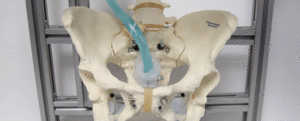
We sought to produce an effect that was rapid in onset and offset, could be sustained for several minutes, was repeatable and produced minimal ‘off target’ effects on other organ systems. If the initial proof of concept experiments in anaesthetised rats proved successful, the next stage of the work would be to translate the findings to chronically instrumented conscious animals.Other projects
IMPRESSplus 2016 projects
IMPRESSplus 2017 projects

